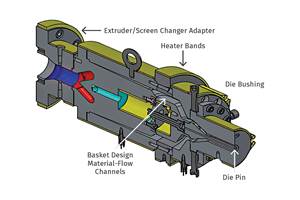They Hit the Market Running
Three years ago, when Martin Grohman and Michael Hurkes started Correct Building Products in Biddeford, Me., it wasn’t so much a start-up as a rocket launch.
Three years ago, when Martin Grohman and Michael Hurkes started Correct Building Products in Biddeford, Me., it wasn’t so much a start-up as a rocket launch. The new firm, which makes wood-filled plastic decking, shot up from $75,000 in sales the first year to $3.5 million the second, and it expects $10 million in sales this year.
Correct Building Products came late to a crowded field. “There are 27 companies making wood-filled decking,” Grohman says, “and 13 started the same year we did.” The plant has run 24 hours, seven days a week almost from the start and has grown from two to 22 full-time employees.
The two-man firm succeeded on the basis of a sound ┤¾¤¾┤½├¢ plan, proprietary technology, and plenty of relevant experience. Though both in their 30s, Grohman, president, and Hurkes, v.p., are well versed in product development, compounding, machine installation, and electronics.
Grohman’s background is polymer chemistry and compounding. He worked for five years at GE Plastics in application development with impact modifiers and stabilizers. He and Hurkes were co-workers at Cincinnati Milacron in Batavia, Ohio, when they hatched dreams of starting their own company to make wood-filled decking. Grohman also wanted to get back to his home state of Maine: “There isn’t much extrusion in Maine, so I started my own.”
Hurkes’ experience was in extrusion machinery installation, electronics, and controls. He worked for 12 years in field service at Milacron. “That experience allowed us to buy all used equipment and redo the controls and electronics to get just what we wanted without taking on a lot of debt,” Grohman says. “So we don’t have to sell a lot of product to make money.”
‘Embossing is our hook’
While most plastic decking is made of HDPE, Correct Building Products produces decking of 60% wood-filled polypropylene. It uses proprietary technology relating to the lubricant package in the compound and hot-rolled embossing of a deep woodgrain pattern. “Aesthetics are where we saw opportunity,” Grohman says. “Embossing is our hook, and so is the PP, which makes a stiffer board.” Their profiles have a flex modulus of 850,000 psi and come in three colors—cedar, gray, and natural. Unlike a lot of wood-filled decking, they also take stain.
The company uses unusually coarse (20 to 80 mesh) sawdust from hardwoods such as oak, birch, and maple. “The mix of sawdusts is extremely important in terms of wood species and particle size,” Grohman says. “We can use anything, but it has to be consistent. For example, softwood flour burns at a lower temperature than hardwoods.”
Sawdust handling was one of the few stumbling blocks they ran into. “We didn’t give enough respect to the difficulties there,” Hurkes recalls. Originally, they leased a fleet of five trucks, using them to store and feed sawdust into the plant. But that system invariably fed either too fast or too slowly because the sawdust bridged in the trucks.
They now unload trucks directly into their silo. The plant processes 200 tons of sawdust a week through its homegrown material-handling system, which holds enough for a day and a half of operation. Sawdust is loaded into the silo with an auger and bucket conveyor. The silo has chain flails to break up bridges. Sawdust is drawn into a rotary steam-tube dryer, which was refitted with sensors to keep an even rate of dryness and feed. Steam was Correct’s choice for a dryer because it only heats up to 300 F, not enough to start a fire.
The firm has two of Milacron’s largest conical twin-screw models, CM 92 HP, and is installing a third. The extruders are modified with a single massive vacuum vent.
Decking profiles are extruded at 375-400 F, cooled in a 20-ft water tank to 120 F, and removed to racks where they are reheated to 220 F. “That cycle of cooling and reheating sets a more highly crystalline structure and makes them stiffer,” Hurkes says. “We are hands down the stiffest composite out there.”
Related Content
Medical Tubing: Use Simulation to Troubleshoot, Optimize Processing & Dies
Extrusion simulations can be useful in anticipating issues and running “what-if” scenarios to size extruders and design dies for extrusion projects. It should be used at early stages of any project to avoid trial and error and remaking tooling.
Read MoreHow to Select the Right Tooling for Pipe Extrusion
In pipe extrusion, selecting or building a complementary set of tooling often poses challenges due to a range of qualitative factors. Here’s some guidance to help you out.
Read MorePart 2 Medical Tubing: Use Simulation to Troubleshoot, Optimize Processing & Dies
Simulation can determine whether a die has regions of low shear rate and shear stress on the metal surface where the polymer would ultimately degrade, and can help processors design dies better suited for their projects.
Read MoreUpdated Software Reduces Die Design Iterations
New software said to reduce the number of fine-tuning iterations and die development time by at least 50%.
Read MoreRead Next
See Recyclers Close the Loop on Trade Show Production Scrap at NPE2024
A collaboration between show organizer PLASTICS, recycler CPR and size reduction experts WEIMA and Conair recovered and recycled all production scrap at NPE2024.
Read MorePeople 4.0 – How to Get Buy-In from Your Staff for Industry 4.0 Systems
Implementing a production monitoring system as the foundation of a ‘smart factory’ is about integrating people with new technology as much as it is about integrating machines and computers. Here are tips from a company that has gone through the process.
Read MoreBeyond Prototypes: 8 Ways the Plastics Industry Is Using 3D Printing
Plastics processors are finding applications for 3D printing around the plant and across the supply chain. Here are 8 examples to look for at NPE2024.
Read More











